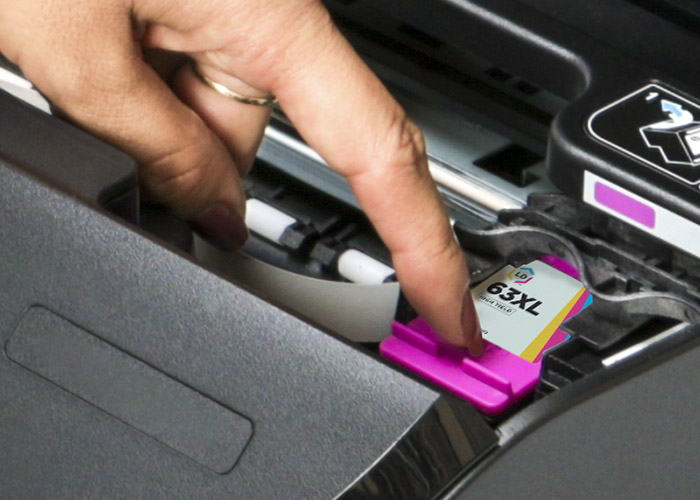Extend the life of your inkjet printer and ink cartridges with these simple cleaning tips.
Printers are an essential part of every home and office, and just like any electronic device, require regular maintenance to work their best. Without a routine cleaning, your machine can become clogged with ink and dust, leading to poor print results and a shorter lifespan. In this article, we will provide a comprehensive guide on how to clean an inkjet printer, and also cover how to clean printheads, and even paper rollers, so you can keep your printer in top shape year round.
Basic Steps for Cleaning Your Inkjet Printer
Step 1: Turn off the printer
First, turn off the printer and unplug it from the wall. Then, open up the printer and remove the cartridges from the cartridge carrier. Be careful not to touch the gold contact points on the cartridges when removing the cartridges from the machine, as this might cause recognition issues. Set the cartridges aside on a clean, flat surface before proceeding to the next step.
Step 2: Clean the outside of the printer
Now it’s time to clean the printer exterior. Use a soft, damp cloth to wipe down the printer and remove any dust or debris. After you’ve wiped it down, be sure to let the printer dry.
Step 3: Clean the inside of the printer
The inside of the printer has many sensitive electronic components that can easily be damaged if not handled properly. If you notice dust inside your printer, it’s okay to gently wipe it away with a dry-lint free cloth but be careful to avoid touching any of the electronic parts of the interior.
Step 4: Clean the paper rollers
Next, clean the printer’s rollers. These are the small rubber or plastic rollers that feed paper through the printer. You can usually find them by removing the paper tray at the bottom of the printer. You may need to lift the printer up and look underneath where the paper feed is to access them. Use a damp, lint-free cloth to wipe them down and rotate as you go so you can clean the entire roller. When you are done, don’t forget to replace the paper tray.
Step 5: Reinstall your cartridges and print a test page
Now that you’ve cleaned and wiped down the interior and exterior of your printer, reinstall the cartridges, turn the printer back on, and print out a test page. If you are still getting streaky or lines on your prints, move on to our printhead cleaning instructions.
How to Clean the Printhead
The printhead is an important part of a printer that transfers ink onto paper by firing tiny droplets of ink through nozzles. When one of these nozzles gets clogged, your prints may appear faded or streaky. To prevent this, regularly clean your printhead with the automatic cleaning function. Most printers come equipped with a printhead cleaning option and it only takes a couple of taps on your printer display screen to get started. Consult your printer manual for specific instructions for you machine. The cleaning will take 1-2 minutes to cycle through. Once it is complete, print out a test page to see if the print quality has improved. If you are not happy with the results, run the cleaning 2-4 more times.
If your printer uses cartridges with an integrated printhead, like most HP and Canon ink cartridges, you can also try the “paper towel method” to clean the printhead.
If you still aren’t getting quality prints after a few cleanings, move on to our manual cleaning instructions.
We’ve provided further printhead instructions for HP, Epson, and Canon printers below:
Common Printer Cleaning FAQs
When should you clean your inkjet printer?
If a printer is not cleaned often, it can lead to clogging of the ink cartridges and printheads, resulting in streaky or uneven printouts. The frequency of cleaning depends on how often the printer is used and the type of ink cartridges used. There are several signs that indicate a printer needs cleaning, such as faded or blurry prints, streaks or lines on the page, or ink smudges on the paper. If you notice any of these signs, it’s time to clean your printer.
What are the best materials to clean an inkjet printer?
- Lint-free cloths or microfiber towels: These are gentle on the sensitive components inside the printer and won’t leave any fibers or residue behind.
- Isopropyl alcohol: This is great for cleaning ink residue, dirt, and dust from printheads. Make sure to use a solution with at least 90% isopropyl alcohol, as lower concentrations may leave residue behind.
- Water: It’s safe to use distilled or filtered water to clean printer parts, but avoid tap water, which can contain impurities that may damage your printer.
Routine cleaning is important to keep your printer is running smoothly, but it’s equally important to print with high-quality ink cartridges. LD-Brand printer cartridges from LD Products are a great way to save money without sacrificing print quality, delivering premium prints that rival the name brand at a fraction of the cost. By following these tips and best practices, you can ensure your printer is in good working condition for years to come. Visit LDProducts.com to shop a range of affordable printer cartridges for nearly every printer model, or find more helpful cleaning content on our Printer and Cartridge Cleaning Tips page.
*Savings based on price comparison between remanufactured/compatible cartridge prices on www.LDProducts.com and OEM cartridge and printer prices from the listed retailers: Amazon and Staples. All products are reviewed independently. As an Amazon associate, LD Products earns from qualifying purchases through links on this page. All prices effective as of April 11, 2023. OEM names are registered trademarks of their respective owners and are not affiliated with, and do not endorse LD Products.
